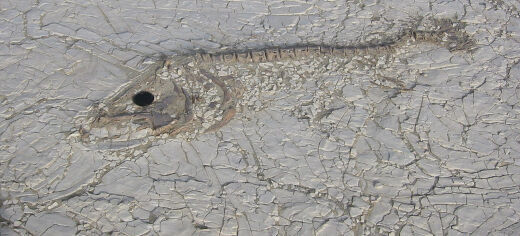
Scientists have uncovered the natural fertiliser contained within Saharan dust that plays an important role in the health of the Amazon rainforest when it is blown across the Atlantic: fish bone.
The research, involving researchers from the University of Leeds, Birkbeck, University of London, and the Diamond Light Source, is published on 25 September 2014 in the print edition of the journal Chemical Geology.
The study analysed dust samples taken from the Bodélé Depression in Chad, in north-central Africa, which is the world’s largest single source of dust.
Dr Caroline Peacock, an Associate Professor in the School of Earth and Environment at the University of Leeds, and a co-author of the paper, said: “We've shown that a significant proportion of the dust exported from the Bodélé region is made up of fossilised fish apatite – a mineral rich in fertilising phosphorus. This source of fertiliser is finite, because there are only limited amounts of fossilised fish material. So, over time, the amount of natural fertiliser that the Amazon receives will diminish.”
Previous research had shown that dust from this area is carried across the equatorial Atlantic and deposited on the Amazon, where it acts as a fertiliser.
The latest study, using data from the Diamond Light Source particle accelerator, shows for the first time that the reason the dust is so beneficial to the rainforest is that it contains the skeletons of fish and other organisms that contain phosphorous – a nutrient essential for photosynthesis. The fish lived in what was once a mega-lake covering the Bodélé Depression, but which dried up over the last 10,000 years.
Dr Karen Hudson-Edwards, a Reader in Birkbeck’s Department of Earth and Planetary Sciences, who led the study, said: “Phosphorous occurs in dust in many different forms, some of which are more soluble than others, and therefore are more readily available to plants. This study helps explain why the Bodélé dust is so important to rainforest growth.”
Phosphorous from biogenic sources (such as fish bone) is more soluble than inorganic sources (such as in rock). This means that the biogenic sources are readily available to plants, whereas inorganic sources will take longer to be dissolved and utilised.
The paper also highlights the fact that the top layers of the Bodélé Depression, which contain the biogenic phosphorous and are the source of the dust, will eventually be fully eroded.
Dr Hudson-Edwards says: “At the moment we don’t know how long the Bodélé Depression will continue to provide phosphorous to the Amazon. With the rainforest already under threat from human activity, we now hope to conduct further research to ascertain when this important source of fertiliser will run out.”
Further information
Dr Caroline Peacock is available for interview. Please contact Sarah Reed, Press Officer at the University of Leeds, on 0113 34 34196 or email s.j.reed@leeds.ac.uk
The paper ‘Solid-phase phosphorus speciation in Saharan Bodélé Depression dusts and source sediments’ is published in Chemical Geology on 25 September 2014.
Image
Caption: A sub-fossil skeleton of a 1.15 metre Nile Perch found in the Bodélé depression.
Credit: Charlie Bristow